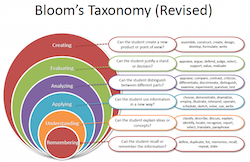Bloom's Taxonomy for Learning
20 Mar 2015Bloom’s Taxonomy is a framework that breaks the learning process into stages. According to Bloom, learning begins with rote memorization and the process progresses upward until we can apply what we’ve learned in creative new ways.
Youthful Bias
Most of my formal education was science or engineering oriented. I regarded science and engineering as the pinnacle of learning. The extreme position of my youth: All logic fell within math and science, while history, language arts, and other non-science areas were just memorization.
Bloom’s research pushed me beyond my original thinking. Memorization and creativity are vital to all areas of knowledge. Here’s how.
Learning Only Starts With Memorization
All learning, at the very beginning, is memorization. For example, when we first learn mathematics, we start by memorizing the counting numbers (1, 2, 3, …) and we eventually figure out that we can’t count to infinity. Later we learn the four basic math operations (addition, subtraction, multiplication, division) and we learn how to apply these operations to word problems. Fast forward a few years, and we learn to apply differential equations to a skydiver falling to earth via parachute. Or we may create a mathematical spreadsheet model to decide whether to invest in a business.
Learning math starts with with memorization. As we advance, we eventually absorb enough to apply what we’ve learned in creative ways.
Bloom’s Taxonomy, Summarized
Bloom’s Taxonomy can be summarized (from lowest level to highest) as follows:
-
Remembering (Lowest Level) - All learning starts with memorization. For example, before we can learn how to read and write the English language, we need to memorize the English alphabet.
-
Understanding - After we memorize the alphabet, we need to understand how the letters come together to form words.
-
Applying - Can we combine words in different ways to form sentences and express thoughts?
-
Analyzing - Spotting differences. Comparing and contrasting. For example, can we take something written by others and express it in our own words while maintaining accuracy?
-
Evaluating - Arguing and appraising. Having completed an analysis, can we justify our conclusions?
-
Creating (Highest Level) - Having achieved at the previous levels, can we move the body of knowledge forward? Can we express entirely new points of view?
More Resources
Google lists tons of articles on Bloom’s Taxonomy if you would like to know more.
Attribution Note
The graphic at the top of this post is from an Oregon State University web site. The original author was not cited. If you know who the original author is, please share the info so that a proper citation can be included here. Thanks!




